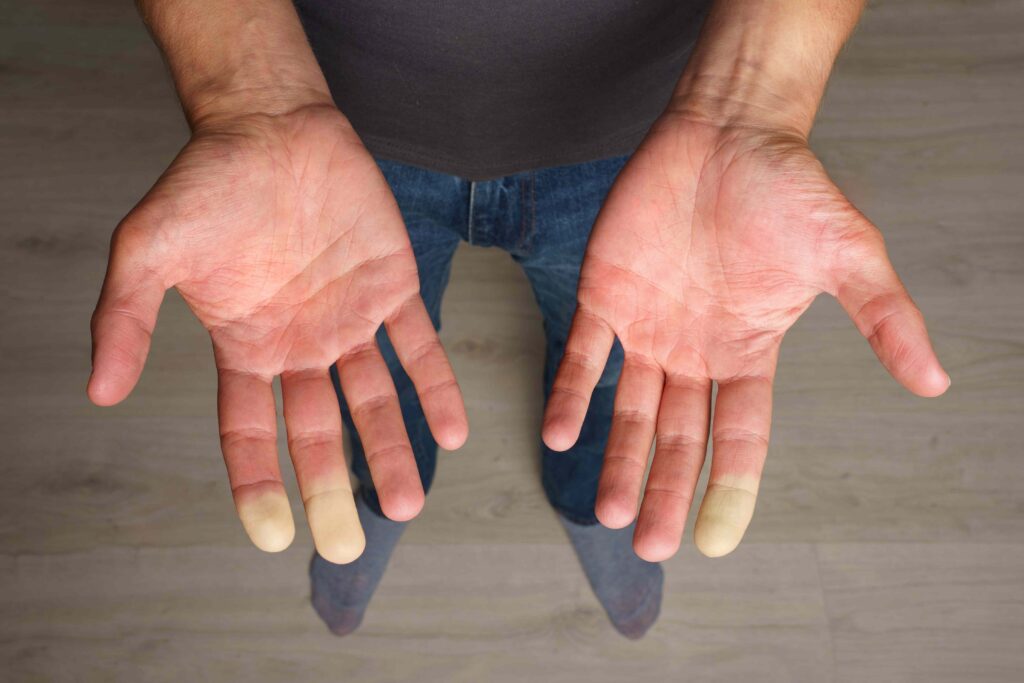Rheumatoid arthritis (RA) commonly causes fatigue and pain, stiffness, and swelling in your joints. Roughly 40% of people also experience one or more symptoms in areas outside the joint. These symptoms are usually due to the abnormal immune response and increased inflammation of rheumatoid arthritis, or as reactions from RA treatments.
Rheumatoid nodules are firm, typically pain-free lumps that develop underneath your skin. They may show up on pressure points, like the back of your elbow or heel. They occur in about 30% of people with RA.
Raynaud’s syndrome affects about 10% of people with RA. With Raynaud’s syndrome, the blood vessels in your hands or feet constrict in response to cold or stress, causing pain or numbness and very pale skin in some of your fingers or toes.
Less commonly, RA can also cause additional skin issues, including:
- An RA rash that resembles eczema or psoriasis
- Reddish palms
- Very dry skin
- Sores or ulcers
Another important skin issue is vasculitis, or inflammation of your blood vessels, which happens in about 2% of people with RA. It typically affects the blood vessels in the skin, causing a painful rash and sometimes fever and nerve pain.
Pleural effusion, a condition where there’s fluid around the sac containing your lungs, happens in about 5% of people with rheumatoid arthritis. This can cause symptoms such as:
- Chest pain
- Shortness of breath
- Cough
Interstitial lung disease, in which the lungs form abnormal scar tissue, can cause similar symptoms in about 21% of people with RA. It’s one of the most potentially serious non-joint symptoms of rheumatoid arthritis.
Lung nodules, or rheumatoid nodules, are noncancerous growths in your lungs that may be visible on a chest X-ray. They don’t often cause symptoms, but your doctor may recommend a lung biopsy to make sure it’s a rheumatoid nodule and not lung cancer.
People with rheumatoid arthritis have an increased risk of atherosclerosis, a hardening of the arteries that doesn’t often cause symptoms but increases the risk of heart attack and stroke.
RA can also increase the risk of pericarditis, or inflammation of the sac around the heart. Mild pericarditis may not cause any symptoms. But if it’s more severe, it might cause symptoms like:
- Sharp chest pain
- Fever
- Shortness of breath
- Low blood pressure
Less commonly, RA can cause other heart problems such as damage to your heart valves or abnormal heart rhythms.
Around 18% of people with rheumatoid arthritis have one or more eye symptoms. The most common issue is very dry eyes, often accompanied by dry mouth. Other symptoms may include:
- Eye redness
- Eye pain
- Blurred vision
- Light sensitivity
- Vision changes
A damaged joint may sometimes start pressing on a nerve. The exact symptoms it causes depend on the nerve being compressed. For example, you might get something similar to carpal tunnel syndrome, with pain, numbness, and tingling in your hands.
A rare condition that occurs in 1% or fewer of people with RA is called Felty syndrome. It decreases certain immune cells in your blood that help fight infections. This puts you at risk of infections that you could normally fight off easily.
Felty syndrome also causes your spleen to enlarge and increases the risk of bruising and bleeding.
Rheumatoid arthritis may also increase your risk of osteoporosis, a condition of weakened and brittle bones that increases the risk of fractures (broken bones).
Some people with rheumatoid arthritis may have an increased risk of hearing loss over time. This may be due to inflammation of the bones in the ear or the use of some medications, such as pain relievers.
Managing your symptoms depends on the type of symptom, its severity, and your overall health. For example, you might need to adjust your regular RA medications, or you might need additional therapies, like eye drops for dry eyes.
A doctor called a rheumatologist, who specializes in diseases such as rheumatoid arthritis, can help you determine the best ways to manage or accommodate any unusual symptoms.
If you have rheumatoid arthritis, the possibility of non-joint symptoms is a good reason to get regular checkups. During these checkups, your provider can screen unsual symptoms through your medical history and exam, blood tests, and medical imaging.
Call the doctor who manages your RA if you experience new symptoms or anything out of the ordinary. For example, let them know about:
- Cough that doesn’t go away
- Mild chest pain
- Mild shortness of breath
- Unusual rash
- Light sensitivity or changes in vision
- Changes in your hearing
For any severe symptoms, like intense eye pain or sudden chest pain with shortness of breath, seek emergency medical treatment.
Rheumatoid arthritis primarily causes symptoms related to your joints, like pain, stiffness, and swelling. Sometimes, the disease can affect other parts of your body, causing symptoms related to your heart, lungs, eyes, skin, and more. It’s important to work with a doctor to screen for and treat any symptoms of RA.


